"I was told that a biker gang were going to murder me for killing off Pandora": artist Ray Zell on the origin, influence and rockin' rebirth of Pandora Peroxide
As legendary comic strip artist Ray Zell launches his website, we salute his most iconic inked creations, Pandora Peroxide and her sassy namesake niece, and reveal how you too can now hang with his queens of noise
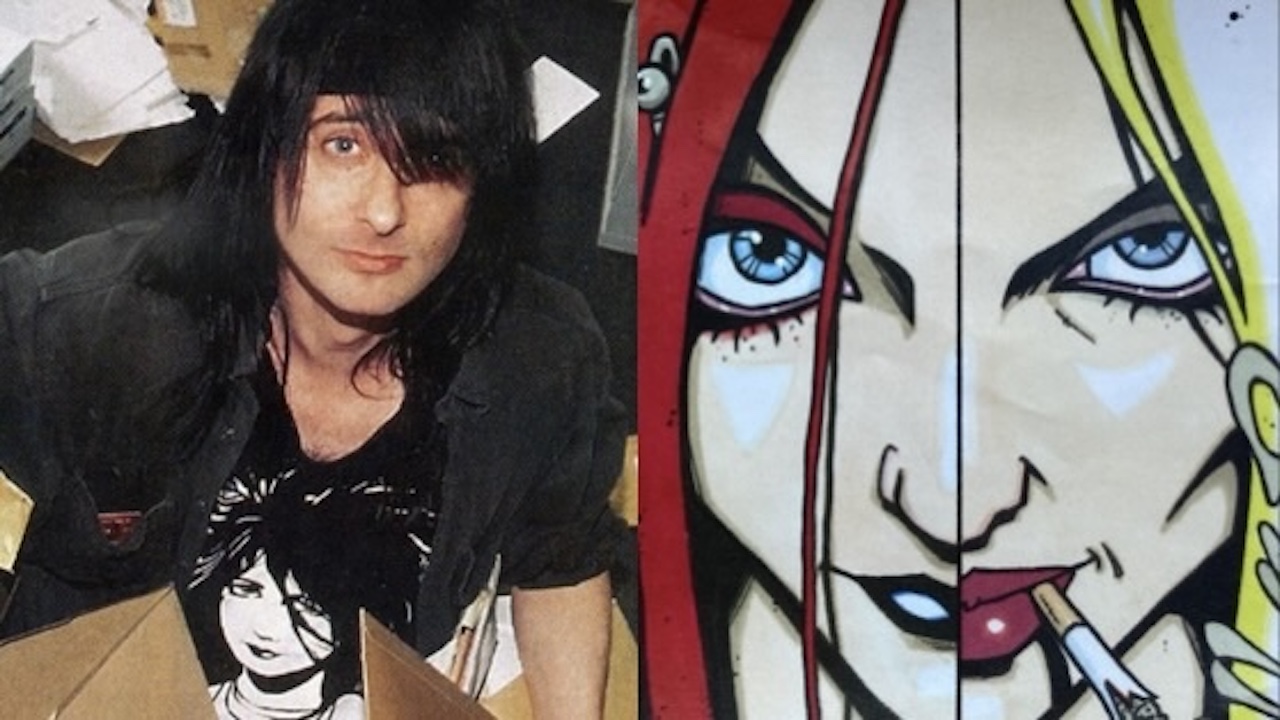
If you picked up an issue of Kerrang! magazine at any point from 1984 to the present day - and chances are, if you're on this website, you did this at least once in your adolescence - you'll instantly recognise the name Ray Zell as the pen, wit and brains behind cartoon bombshell Pandora Peroxide and, post-grunge, her sassy, skater girl niece Pandora.
London-based illustrator / comic strip artist Zell has put a treasure trove of vintage, original Pandora Peroxide/Pandora artwork online for sale on his newly-launched website, and browsing through the collection is sure to evoke warm memories for former readers of 'The Rock Bible'.
However, the site isn't just pure nostalgia, for Zell has also given Pandora and 'Auntie' P a new online column, Blood and Peroxide, where the dynamic duo offer up their thoughts on Ghost, Måneskin, Poppy, Mötley Crüe and anything else that might take their fancy.
We sat down with Zell in a north London bar for a Jack-and-Red Bull-fuelled stumble down memory lane to get the the inside story of rock's most iconic comic strip, and learn of the re-birth of Pandora Peroxide as a modern day rock n' roll influencer.

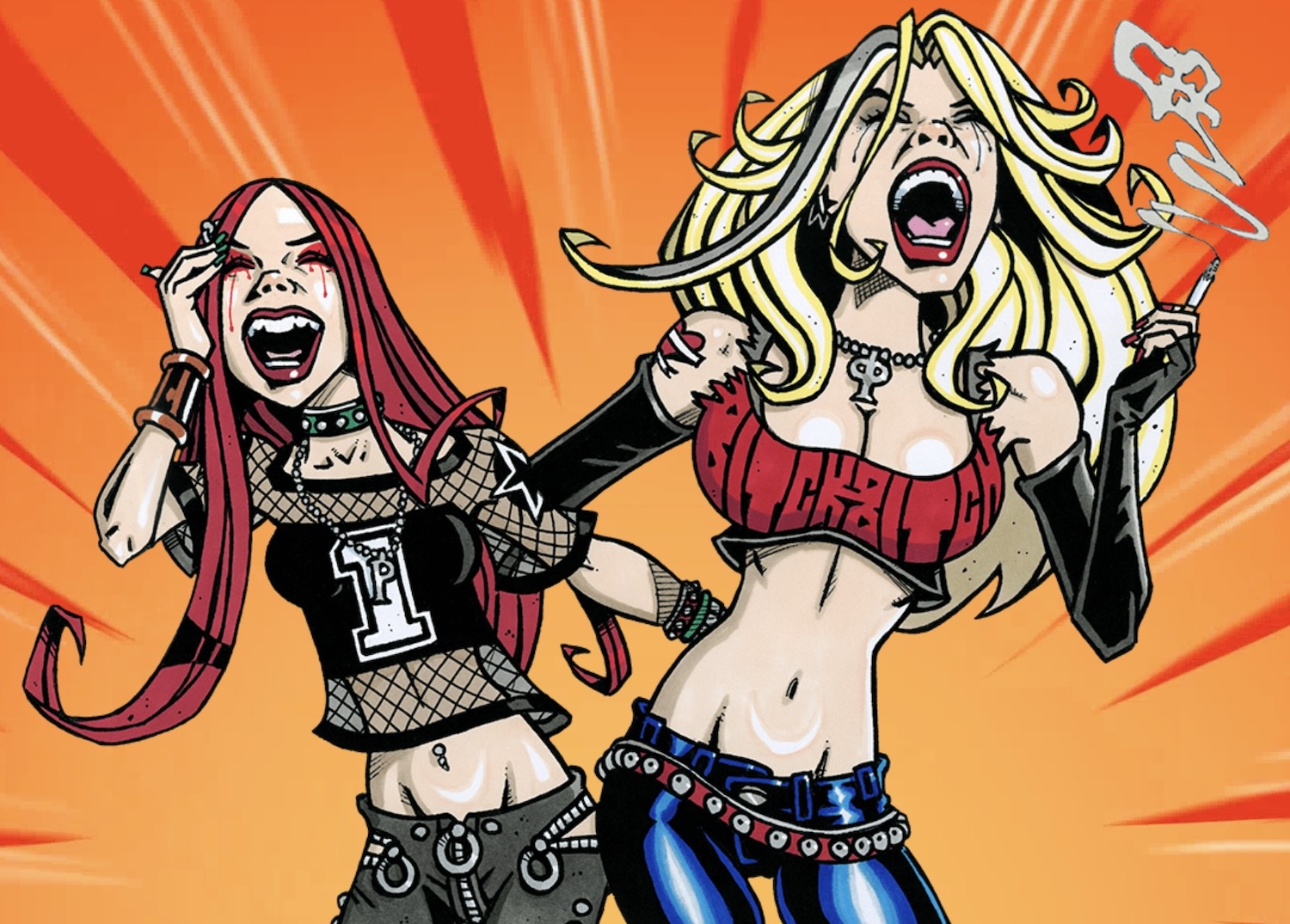
How did the original Pandora Peroxide come to be in Kerrang in the 1980s?
"Well, basically, I remember being at an after-show party with a load of rock bands, back when I was playing in my band Marionette, and I said, I'm going to draw a comic strip for Kerrang! - because I noticed they'd had a couple in the magazine over the years, which lasted one or two weeks. And everyone went, 'Not a good idea, they've tried it, it doesn't work, Kerrang! doesn't want a comic strip.' And that made me go, Okay, well, then I'm definitely going to do it.
"The one thing I didn't want to do was draw a guy - I think if I'd drawn a character who looked like a Motörhead roadie, it would have disappeared quickly just like the previous comic strips - so I sent Geoff Barton (ex-Kerrang! editor, turned Classic Rock writer) two half page black and white strips featuring the original Pandora with a note saying, 'When do you want the next one?' And he wrote back saying that the first two were going into an off-shoot mag called Extra Kerrang! and so he would need one as soon as possible for the 'regular' issue. It was that easy.
"That was 1984, and Pandora, the original Pandora's niece, still features in the print issues of Kerrang! today."
Did you explain the idea behind Pandora to anyone at the magazine at any point?
"No, but I made it kinda self-explanatory, because in the very first panel, she's smashing her fists down on Geoff Barton's desk saying, 'I want hype and publicity!' To me, it was like a female bomb landing in the middle of a male-dominated rock world. I wanted her to be punky, and a bit 'biker': the two key influences I was drawing from to create her were Beki Bondage and Wendy O. Williams."
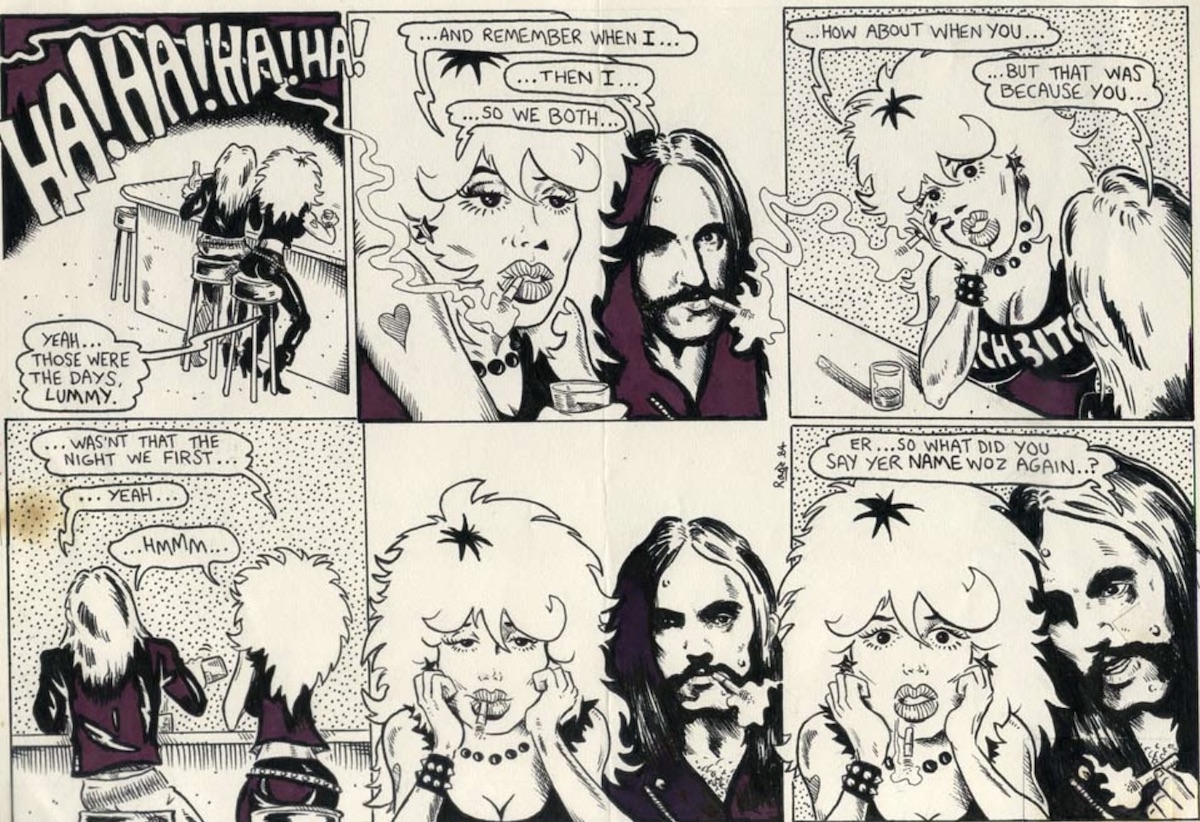
On your Instagram page, you posted an image from a 2006 article in Arena magazine feature on 'sexual awakenings' in which they described the original Pandora as "an enormous-breasted, bleach-haired groupie slag", which says a lot more about the writer of that article than it does about your creation.
As a Kerrang! reader in the mid '80s, I remember Pandora as something of a feminist icon, a character who took no shit whatsoever, lived her life totally unapologetically, and was a cooler 'rock star' than almost all of the musicians in the magazine...
"I can't pretend that I was thinking like that, but growing up, I was always drawn to strong female characters. Like, you had Emma Peel in The Avengers who used to fight the bad guys while [her crime-fighting partner] John Steed stood in the background, having a drink and twirling his umbrella. Or, like, Catwoman in Batman had a male gang and she was the leader.
"I was encouraged by Geoff Barton and [Kerrang! writer-turned-Classic Rock founding editor Mick Wall] to make the strip madder and wilder and so Pandora had the freedom to be exactly who she wanted to be."
The latest news, features and interviews direct to your inbox, from the global home of alternative music.
You were hanging out at gigs and parties with many of the bands who featured in the strip, so did anyone ever confront you about how they'd been portrayed in the strip?
"For the most part, they were really flattered to be in it. I think the only person who didn't get it was Charlie Simpson, who'd been in [pop-punk boy-band] Busted, before he entered the big boy rock world with his band Fightstar. Everyone else loved having Pandora take the piss out of them, but he couldn't seem to deal with it. He went so far as to get someone to draw their own comic strip in which Fightstar got the better of a really badly-drawn Pandora, which Kerrang! actually printed. I remember being at one Kerrang! Awards where I'd heard he was going to 'sort me out' so I went up and introduced myself and he just laughed and shook my hand. To be fair, he was really drunk, and was swaying like a tall tree in a storm at the time...
"But Pandora always had a whipping boy band at any given time. For a while, it was the band Skin, but they ended up putting Pandora on the cover of a single [1994's Look But Don't Touch EP], and later appeared on the cover of Kerrang! alongside Pandora. It's funny how people can have such different perspectives. To me, everyone who featured in Pandora was in our big rock 'n' roll family, and families have a laugh at one another. I saw her as someone who could sit down in a pub with a band and take the piss, but if someone outside the family walked in and started taking the piss out of that band, she'd stand up and knock that person out!"

In the '90s, post Nevermind, Pandora Peroxide gave way to her niece Pandora, who was more of a grungey, skater girl character. Was that a diktat from above?
"As I remember it, Kerrang! had a re-design, as happens every few years with magazines, and the editor at the time, Phil Alexander, was showing the writers the new look, showing off his new 'baby' as all proud parents do.
"At the time I actually had two strips in the mag, the second one being Kontinuum, and as Phil was showing me through the mock-up of how the new Kerrang! would look, halfway through he said, 'Oh, I should probably mention, Pandora's not in it anymore.' That's how I found out.
"I was actually kinda shellshocked: it felt like I was having an out-of-body experience. And then letters from readers confused as to what was going on starting coming in. I remember the magazine printed one letter which said, 'Pandora is my role model, where has she gone?' So then Phil asked me to have a conversation about 'modernising' Pandora, and making her more grunge/skate-core/nu-metal/whatever.
"I actually did a strip where the original Pandora was abducted by aliens, well, an ape, a pig and a spaceman, if anyone remembers that band, and she was genetically altered into this new version. Everyone loved that idea initially, but then a week or so later Kerrang! decided that didn't work, really, and they wanted a proper new Pandora. Someone on the staff - and I won't say who - actually said to me, 'Let's face it Ray, give it a couple of weeks and no-one is even going to remember Pandora Peroxide.' Like, okaaaay, cheers!
"For about two years, everywhere I went, people would come up to me and tell me that they hated the new Pandora. They were really offended, it was like they took it as a personal insult that this little grunge girl had suddenly replaced their Amazonian bombshell with no word of explanation in the magazine. People were really angry. The next time I went to Donington, the whole day I had people abusing me, calling me a sell-out. It was horrible, actually.
"My favourite one was a guy who told me that he knew a biker gang who'd got Pandora Peroxide as their mascot, and that if they saw me, they were going to kill me. And I was thinking, Hmmm, that's maybe a tad extreme. [Laughs] It was nice that people were that passionate about Pandora, but maybe not to the point of committing murder!
"Actually, you were the first person who told me that you liked the new Pandora more than the original Pandora. You might not remember that, but you were the very first person to speak up for the new Pandora."
By the time I became editor of Kerrang! in 2005, everyone loved the 'new' Pandora though: she was everyone's smart, cool, funny mate, and she became iconic to a whole new generation of readers/rock fans...
"Trust me, I love 'new' Pandora. But yeah, the transition period wasn't fun. Maybe I was an egomaniac, but all I ever used to hear was 'Loved Pandora this week' with the original strip, and then suddenly it was, 'What are you doing? What is that supposed to be?' Affection for the new character certainly didn't happen overnight. But gradually she got accepted, and then, because of the family connection, I could also bring Auntie P back into the strip now and then and it didn't look weird."
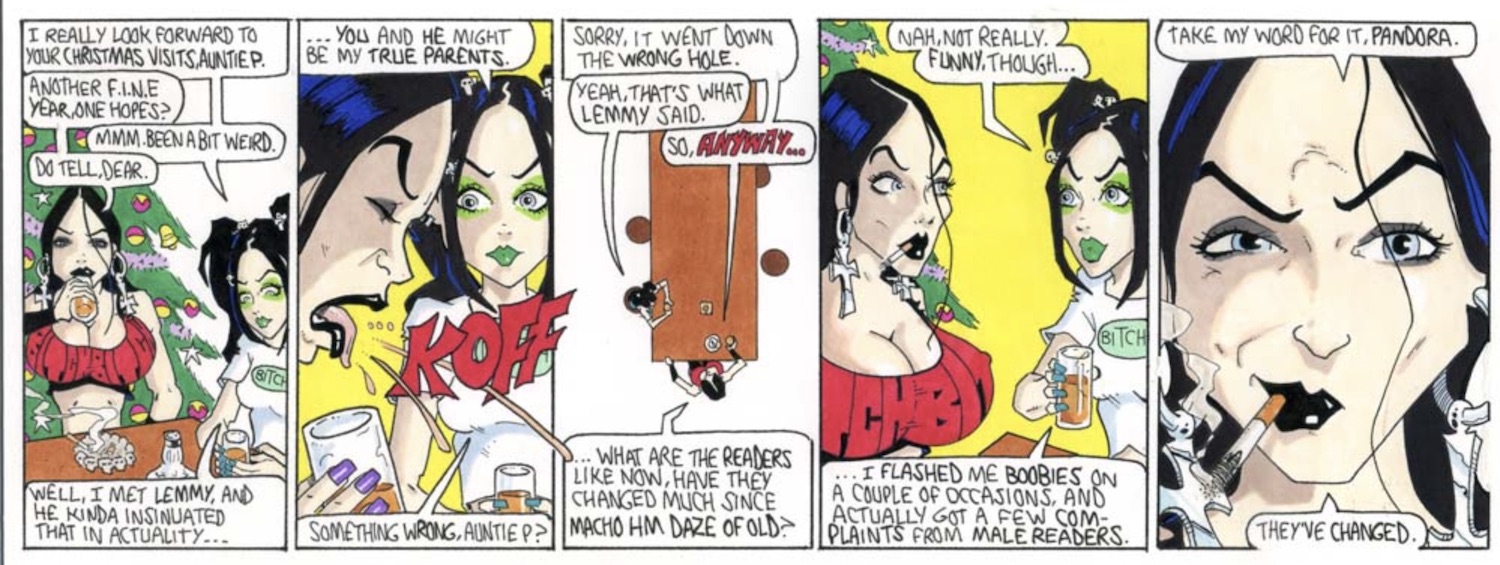
Were there any occasions when a strip you submitted was censored or rejected?
"Well, I submitted a strip after Kurt Cobain killed himself and was told that the magazine couldn't run it. Basically, I'd drawn it with Pandora slumped in a chair, deflated, because she'd just read the news of Kurt Cobain's death in a newspaper, and was heartbroken. And the speech bubble above her just had two words in it, which were 'Stupid fucker', which was an indication of how upset she was.
"So I left the strip in the office as usual, and was talking to one of the magazine designers in the office upstairs, and Phil Alexander came running in and said, 'I can't print this!' But when I went back into the office with him, the rest of the staff were like, 'But look at her posture, she's obviously depressed, and hurting.' Phil was so sensitive about it though, and he thought it might look disrespectful, so in the end, her words were blanked out and replaced with '...', to suggest that she was speechless after hearing the news. Which made sense too, but just wasn't as powerful, in my opinion.
"In later years, words such as 'offensive' or 'inappropriate' were coming up on occasion, and the magazine became much more sensitive about potentially upsetting bands or readers. And then there was a point where basically I was being nudged into positioning Pandora as a cheerleader for the magazine, and taking the piss or sending people up was really frowned upon. I started getting directives, which always seemed to be, like, 'Hey, this happened this week, how great is that!' and Pandora was supposed to be giving the thumbs up to someone every week.
"An example of how sensitive Kerrang! became was when I did a strip featuring a band called Hands Off Gretel. Basically, their singer, Lauren [Tate], wrote a blog on social media about the sexism and misogyny she constantly faced, calling out guys who were groping her at shows, and calling out male fans who were crossing boundaries and being disrespectful and inappropriate and abusive.
"So I did a strip with Pandora supporting her, and backing up her words, while also saying that we weren't trying to suggest that all male rock fans behaved like this, but that this behaviour had to stop. And Kerrang! wouldn't print it. Which was a shock to me, because it was very clearly against sexism, and supportive of Lauren's comments. In the end, I gave it to Lauren and she loved it and put it on her social media pages and on the band's website, and the fans loved it. So after that, I was kinda floundering, because I was thinking, Well, I don't know who or what Pandora is supposed to be anymore.
"I should stress that this is past history, and there's a new editorial team now at Kerrang! There are still print issues of Kerrang! published around big events in the rock calendar, and Pandora is in those issues as a full page strip, still very much part of the magazine."
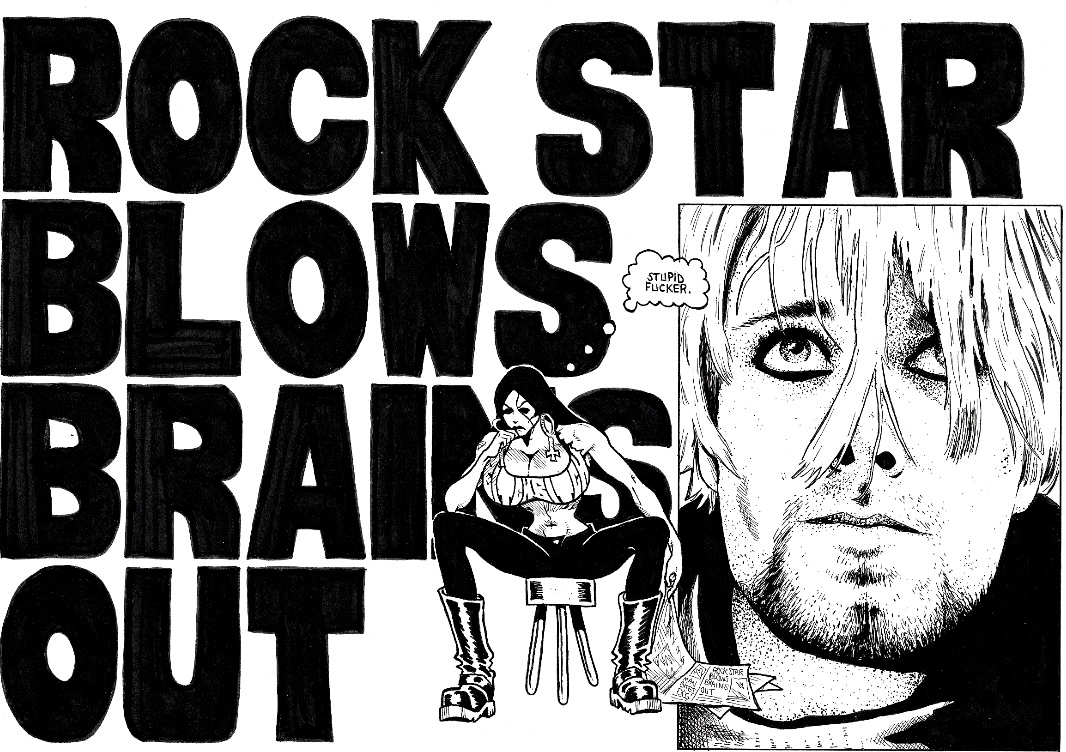
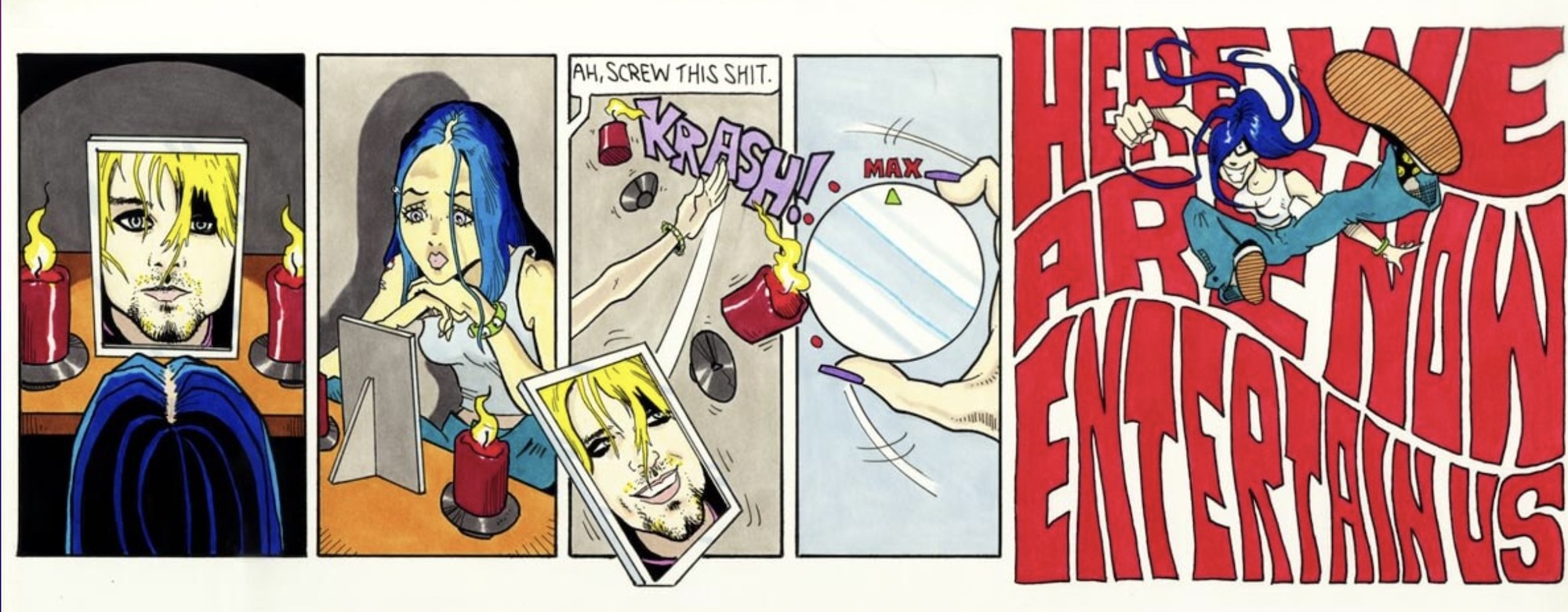
So you've just launched rayzell.com as a new home for Pandora and 'Auntie P', with original, one-off strips on sale for the first time ever, details on how site visitors can order unique, personalised, hand-drawn art pieces, and a regularly updated blog featuring the uncensored, unfiltered musings of our heroines.
One final question: after all this time, what prompted this?
"Well, originally I wanted to create a space where old school Pandora and new school Pandora could poke fun at recent news stories, and that idea kinda spiralled into a one-stop site encompassing those various features.
"I've never sold any original strips before: I just used to give them away for free to the first person to ask for them, whether that was a reader or a rock star, and the delighted, thrilled reaction I'd get back was all the 'payment' I needed. I hate charging for anything, but apparently it's not possible to use comic strips as currency to pay bills and buy food and cover rent, so the option is there for those who wish to buy the original artwork and not just browse through the archives. There's only one original copy of each strip, and once they're gone, they're gone forever.
"People keep telling me how cool it is to see Pandora back, which is sweet, and lovely to hear, but really, she never went away! So now you know where to find her, come hang out anytime."
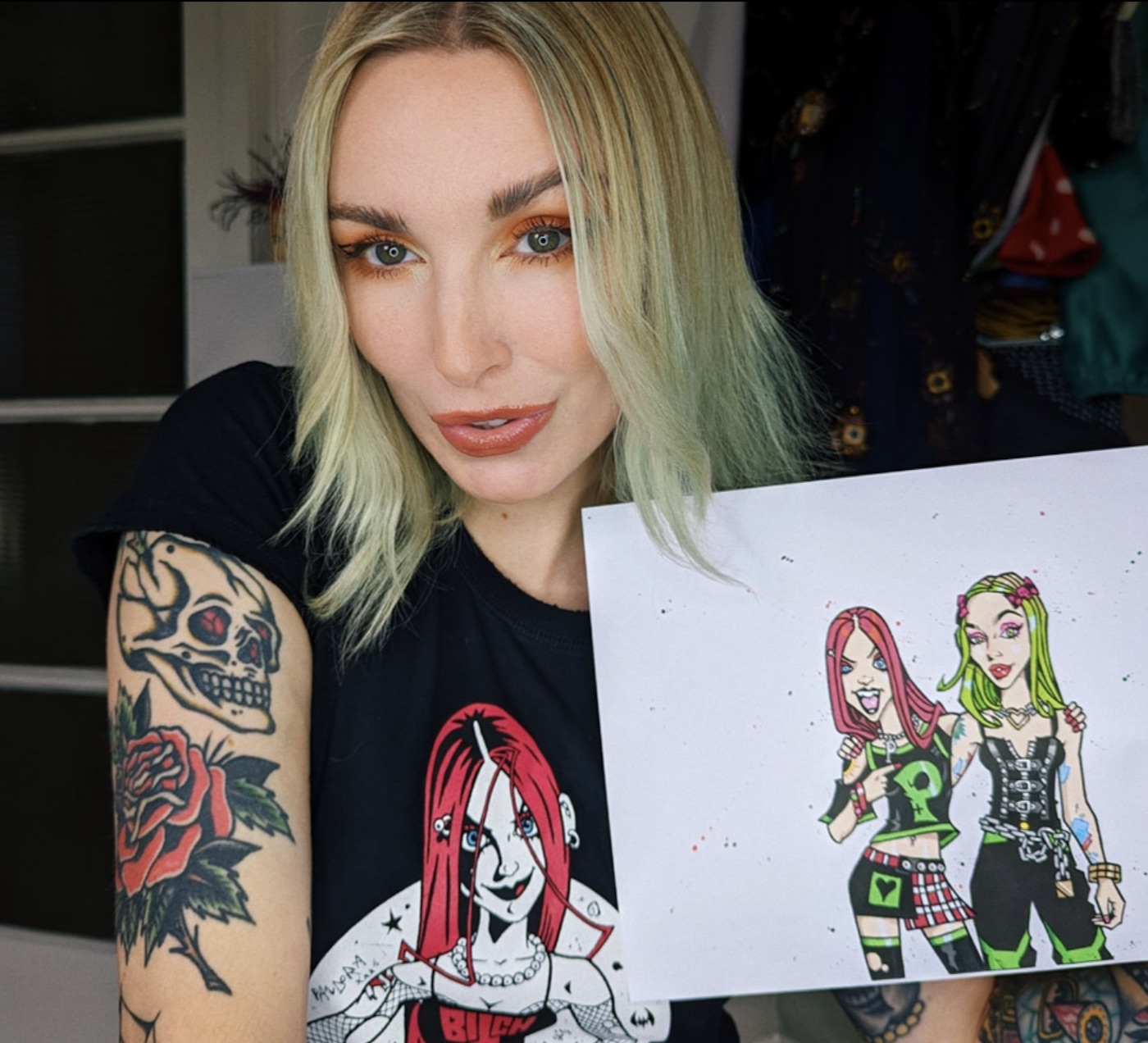
For more information visit rayzell.com or Zell's official Instagram page.

A music writer since 1993, formerly Editor of Kerrang! and Planet Rock magazine (RIP), Paul Brannigan is a Contributing Editor to Louder. Having previously written books on Lemmy, Dave Grohl (the Sunday Times best-seller This Is A Call) and Metallica (Birth School Metallica Death, co-authored with Ian Winwood), his Eddie Van Halen biography (Eruption in the UK, Unchained in the US) emerged in 2021. He has written for Rolling Stone, Mojo and Q, hung out with Fugazi at Dischord House, flown on Ozzy Osbourne's private jet, played Angus Young's Gibson SG, and interviewed everyone from Aerosmith and Beastie Boys to Young Gods and ZZ Top. Born in the North of Ireland, Brannigan lives in North London and supports The Arsenal.
